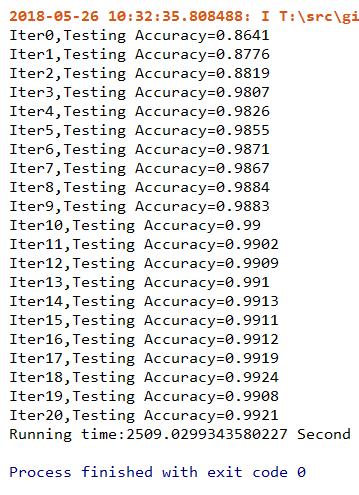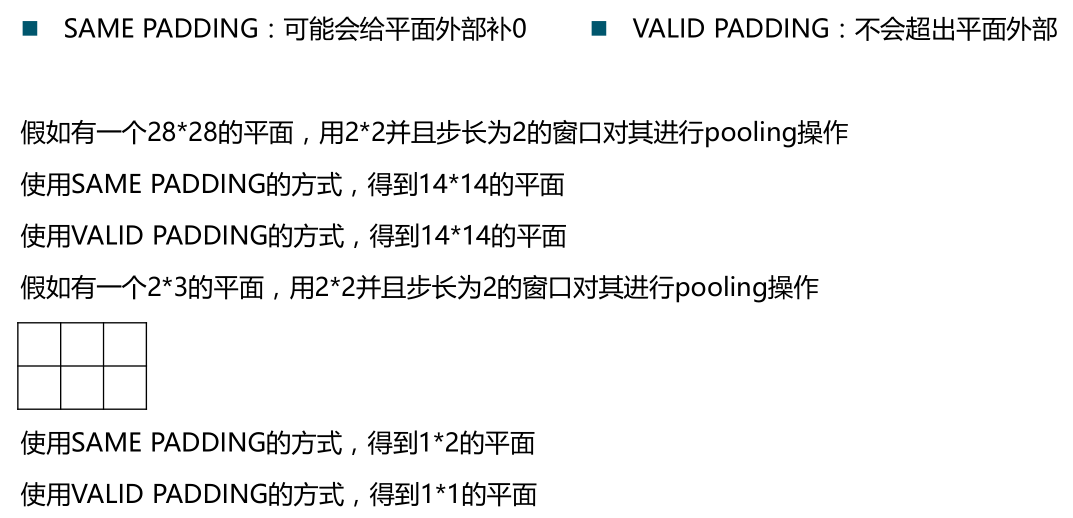CNN卷积神经网络处理Mnist数据集
CNN模型结构:

输入层:Mnist数据集(28*28)
第一层卷积:感受视野5*5,步长为1,卷积核:32个
第一层池化:池化视野2*2,步长为2
第二层卷积:感受视野5*5,步长为1,卷积核:64个
第二层池化:池化视野2*2,步长为2
全连接层:设置1024个神经元
输出层:0~9十个数字类别
代码实现:
import tensorflow as tf
#Tensorflow提供了一个类来处理MNIST数据
from tensorflow.examples.tutorials.mnist import input_data
import time
#载入数据集
mnist=input_data.read_data_sets('MNIST_data',one_hot=True)
#设置批次的大小
batch_size=100
#计算一共有多少个批次
n_batch=mnist.train.num_examples//batch_size
#定义初始化权值函数
def weight_variable(shape):
initial=tf.truncated_normal(shape,stddev=0.1)
return tf.Variable(initial)
#定义初始化偏置函数
def bias_variable(shape):
initial=tf.constant(0.1,shape=shape)
return tf.Variable(initial)
#卷积层
def conv2d(input,filter):
return tf.nn.conv2d(input,filter,strides=[1,1,1,1],padding='SAME')
#池化层
def max_pool_2x2(value):
return tf.nn.max_pool(value,ksize=[1,2,2,1],strides=[1,2,2,1],padding='SAME')
#输入层
#定义两个placeholder
x=tf.placeholder(tf.float32,[None,784]) #28*28
y=tf.placeholder(tf.float32,[None,10])
#改变x的格式转为4维的向量[batch,in_hight,in_width,in_channels]
x_image=tf.reshape(x,[-1,28,28,1])
#卷积、激励、池化操作
#初始化第一个卷积层的权值和偏置
W_conv1=weight_variable([5,5,1,32]) #5*5的采样窗口,32个卷积核从1个平面抽取特征
b_conv1=bias_variable([32]) #每一个卷积核一个偏置值
#把x_image和权值向量进行卷积,再加上偏置值,然后应用于relu激活函数
h_conv1=tf.nn.relu(conv2d(x_image,W_conv1)+b_conv1)
h_pool1=max_pool_2x2(h_conv1) #进行max_pooling 池化层
#初始化第二个卷积层的权值和偏置
W_conv2=weight_variable([5,5,32,64]) #5*5的采样窗口,64个卷积核从32个平面抽取特征
b_conv2=bias_variable([64])
#把第一个池化层结果和权值向量进行卷积,再加上偏置值,然后应用于relu激活函数
h_conv2=tf.nn.relu(conv2d(h_pool1,W_conv2)+b_conv2)
h_pool2=max_pool_2x2(h_conv2) #池化层
#28*28的图片第一次卷积后还是28*28,第一次池化后变为14*14
#第二次卷积后为14*14,第二次池化后变为了7*7
#经过上面操作后得到64张7*7的平面
#全连接层
#初始化第一个全连接层的权值
W_fc1=weight_variable([7*7*64,1024])#经过池化层后有7*7*64个神经元,全连接层有1024个神经元
b_fc1 = bias_variable([1024])#1024个节点
#把池化层2的输出扁平化为1维
h_pool2_flat = tf.reshape(h_pool2,[-1,7*7*64])
#求第一个全连接层的输出
h_fc1=tf.nn.relu(tf.matmul(h_pool2_flat,W_fc1)+b_fc1)
#keep_prob用来表示神经元的输出概率
keep_prob=tf.placeholder(tf.float32)
h_fc1_drop=tf.nn.dropout(h_fc1,keep_prob)
#初始化第二个全连接层
W_fc2=weight_variable([1024,10])
b_fc2=bias_variable([10])
#输出层
#计算输出
prediction=tf.nn.softmax(tf.matmul(h_fc1_drop,W_fc2)+b_fc2)
#交叉熵代价函数
cross_entropy=tf.reduce_mean(tf.nn.softmax_cross_entropy_with_logits(labels=y,logits=prediction))
#使用AdamOptimizer进行优化
train_step=tf.train.AdamOptimizer(1e-4).minimize(cross_entropy)
#结果存放在一个布尔列表中(argmax函数返回一维张量中最大的值所在的位置)
correct_prediction=tf.equal(tf.argmax(prediction,1),tf.argmax(y,1))
#求准确率(tf.cast将布尔值转换为float型)
accuracy=tf.reduce_mean(tf.cast(correct_prediction,tf.float32))
#创建会话
with tf.Session() as sess:
start_time=time.clock()
sess.run(tf.global_variables_initializer()) #初始化变量
for epoch in range(21): #迭代21次(训练21次)
for batch in range(n_batch):
batch_xs,batch_ys=mnist.train.next_batch(batch_size)
sess.run(train_step,feed_dict={x:batch_xs,y:batch_ys,keep_prob:0.7}) #进行迭代训练
#测试数据计算出准确率
acc=sess.run(accuracy,feed_dict={x:mnist.test.images,y:mnist.test.labels,keep_prob:1.0})
print('Iter'+str(epoch)+',Testing Accuracy='+str(acc))
end_time=time.clock()
print('Running time:%s Second'%(end_time-start_time)) #输出运行时间
运行结果:

TensorFlow主要函数说明
1、卷积层
tf.nn.conv2d(input, filter, strides, padding, use_cudnn_on_gpu=None, data_format=None, name=None)
(1)data_format:表示输入的格式,有两种分别为:“NHWC”和“NCHW”,默认为“NHWC”
(2)input:输入是一个4维格式的(图像)数据,数据的 shape 由 data_format 决定:当 data_format 为“NHWC”输入数据的shape表示为[batch, in_height, in_width, in_channels],分别表示训练时一个batch的图片数量、图片高度、 图片宽度、 图像通道数。当 data_format 为“NHWC”输入数据的shape表示为[batch, in_channels, in_height, in_width]
(3)filter:卷积核是一个4维格式的数据:shape表示为:[height,width,in_channels, out_channels],分别表示卷积核的高、宽、深度(与输入的in_channels应相同)、输出 feature map的个数(即卷积核的个数)。
(4)strides:表示步长:一个长度为4的一维列表,每个元素跟data_format互相对应,表示在data_format每一维上的移动步长。当输入的默认格式为:“NHWC”,则 strides = [batch , in_height , in_width, in_channels]。其中 batch 和 in_channels 要求一定为1,即只能在一个样本的一个通道上的特征图上进行移动,in_height , in_width表示卷积核在特征图的高度和宽度上移动的布长。
(5)padding:表示填充方式:“SAME”表示采用填充的方式,简单地理解为以0填充边缘,当stride为1时,输入和输出的维度相同;“VALID”表示采用不填充的方式,多余地进行丢弃。
对于卷积操作:


2、池化层
#池化层: #Max pooling:取“池化视野”矩阵中的最大值 tf.nn.max_pool( value, ksize,strides,padding,data_format=’NHWC’,name=None) #Average pooling:取“池化视野”矩阵中的平均值 tf.nn.avg_pool(value, ksize,strides,padding,data_format=’NHWC’,name=None)

